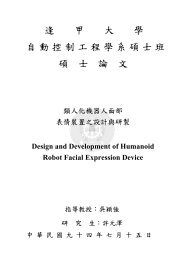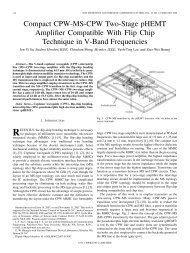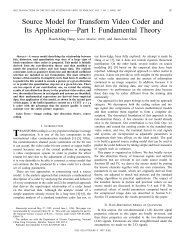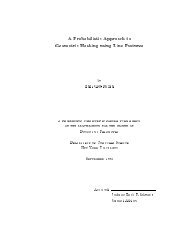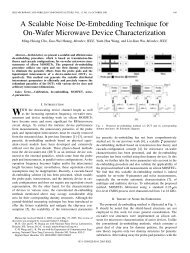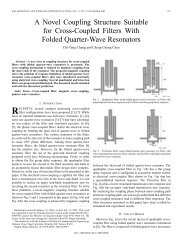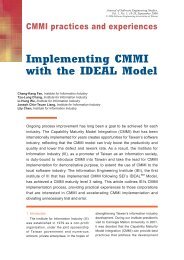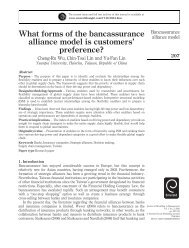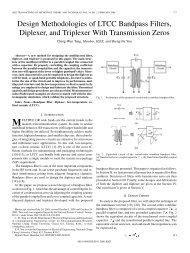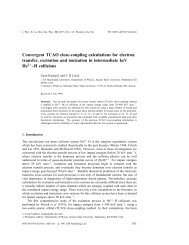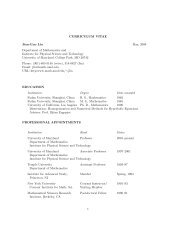Pragmatic, Unifying Algorithm Gives Power Probabilities for ...
Pragmatic, Unifying Algorithm Gives Power Probabilities for ...
Pragmatic, Unifying Algorithm Gives Power Probabilities for ...
Create successful ePaper yourself
Turn your PDF publications into a flip-book with our unique Google optimized e-Paper software.
O'Brien and Shieh: <strong>Power</strong> <strong>for</strong> the Multivariate Linear Hypothesis<br />
Î = Ν(A′ÍA) –1 (CBA – Œ 0 )′[CÁ -1 C′] -1 (CBA – Œ 0 )}<br />
= N(A′ÍA) –1 H ∗ = NÎ ∗ .(2.2)<br />
H ∗ is the population counterpart of H/N. Let ƒ ∗ = {φ1 ∗ , ..., φ∗ 2 } to be the eigenvalues of<br />
Î ∗ = (A′ÍA) –1 H ∗ , the population counterpart of E –1 H. As N → ∞, Bˆ<br />
→ p B,<br />
H/N → p H ∗ , and E/N → p A′ÍA, so that NE -1 → p (A′ÍA) –1 . Thus, E -1 H → p (A′ÍA) –1 H ∗<br />
and ƒ → p ƒ ∗ .<br />
We shall specify and asymptotically justify all F distributions using a common<br />
notation and logic. First, take F i to be an F random variable with ν 1 = r C r A and ν 2<br />
(i)<br />
degrees of freedom and noncentrality λ i = Nλ ∗ i , a <strong>for</strong>m motivated by (2.1) and (2.2).<br />
Accordingly, E(F i /N) = N -1 (1 + λ i /ν 1 )[ν (i)<br />
2 /(ν (i)<br />
2 – 2)] → λ ∗ i /ν 1 , as N → ∞. Also, <strong>for</strong><br />
each F i , F i /N → p f ∗ i , a constant. This leads to the approximation λ ∗ i = ν 1 f ∗ i . Each f ∗ i is a<br />
function of r C , r A and ƒ ∗ as specified below. Finally, we cite specific theory reviewed by<br />
Anderson (1984, Section 8.6.5) to outline why <strong>for</strong> the Hotelling and Pillai statistics, ν 1 F i<br />
converges to noncentral χ 2 distributions with the noncentralities proposed here. Likewise,<br />
the work of Kulp and Nagarsenker (1984) supports the convergence of ν 1 F U <strong>for</strong> the<br />
noncentral Wilks statistic.<br />
Motivated because E/(N – r X ) is the unbiased estimator of A′ÍA, Muller and<br />
Peterson (1984) proposed extracting the eigenvalues, ƒ (M) , of [(A′ÍA) –1 /(N – r X )][NH ∗ ].<br />
Thus, ƒ (M) =[N/(N – r X )]ƒ ∗ . Furthermore, they proposed making λ (M)<br />
i = ν 2 (i) ν 1 f (M) i ,<br />
where f (M) i uses ƒ (M) just as f ∗ i uses ƒ ∗ . One can easily show that <strong>for</strong> r A = 1 both<br />
methods lead to the exact univariate noncentrality given above. If r A > 1, λ (M)<br />
i < λ i , but<br />
λ i /λ (M)<br />
i → 1 as N → ∞.<br />
Muller and Barton (1989) used a similar strategy to define approximations of the<br />
non-null distributions of F statistics <strong>for</strong> univariate approaches <strong>for</strong> repeated measures<br />
analysis. O'Brien (1986) also applied the strategy to characterize the non-null<br />
distribution of the likelihood-ratio χ 2 statistic commonly used in log-linear models; c.f.<br />
Agresti (1990, Section 7.6.4).<br />
5



